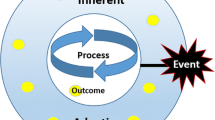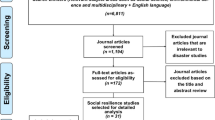Abstract
This article contributes to the disaster literature by measuring and connecting two concepts that are highly related but whose relationship is rarely empirically evaluated: social vulnerability and community resilience. To do so, we measure community resilience and social vulnerability in counties across the United States and find a correlation between high levels of vulnerability and low levels of resilience, indicating that the most vulnerable counties also tend to be the least resilient. We also find regional differences in the distribution of community resilience and social vulnerability, with the West being particularly vulnerable while the Southeast is prone to low levels of resilience. By looking at both social vulnerability and community resilience, we are able to map communities’ social risks for harm from threats as well as their capacities for recovering and adapting in the aftermath of hazards. This provides a more complete portrait of the communities that might need the most assistance in emergency planning and response, as well as whether such interventions will need to be tailored toward reducing damage or finding the path to recovery.





Similar content being viewed by others
References
Adger, W. N. (1999). Social vulnerability to climate change and extremes in coastal Vietnam. World Development, 27, 249–269.
Alwang, J., Siegel, P. B., & Jorgensen, S. L. (2001) Vulnerability: A view from different disciplines. Washington, DC: World Bank Social Protection Discussion Paper Series, No. 115.
Brooks, N., Adger, W. N., & Kelly, P. M. (2005). The determinants of vulnerability and adaptive capacity at the national level and the implications for adaptation. Global Environmental Change, 15, 151–163.
Bruneau, M., Chang, S. E., Eguchi, R. T., Lee, G. C., O’Rourke, T. D., Reinhorn, A. M., et al. (2003). A framework to quantitatively assess and enhance the seismic resilience of communities. Earthquake Spectra, 19, 733–752. doi:10.1193/1.1623497.
Coles, E., & Buckle, P. (2004). Developing community resilience as a foundation for effective disaster recovery. Australian Journal of Emergency Management, 19, 6–15.
Cutter, S. L. (1996). Vulnerability to environmental hazards. Progress in Human Geography, 20, 529–539. doi:10.1177/030913259602000407.
Cutter, S. L., Barnes, L., Berry, M., Burton, C., Evans, E., Tate, E., et al. (2008). A place-based model for understanding community resilience to natural disasters. Global Environmental Change, 18, 598–606. doi:10.1016/j.gloenvcha.2008.07.013.
Cutter, S. L., Boruff, B. J., & Shirley, W. L. (2003). Social vulnerability to environmental hazards. Social Science Quarterly, 84, 242–261. doi:10.1111/1540-6237.8402002.
Cutter, S. L., Mitchell, J. T., & Scott, M. S. (2000). Revealing the vulnerability of people and places: A case study of Georgetown County, South Carolina. Annals of the Association of American Geographers, 90, 713–737. doi:10.1111/0004-5608.00219.
Dash, N., McCoy, B. G., & Herring, A. (2010). Class. In B. D. Phillips, D. S. K. Thomas, A. Fothergill, & L. Blinn-Pike (Eds.), Social vulnerability to disasters (pp. 75–100). Boca Raton, FL: CRC Press.
de Oliveira Mendes, J. M. (2009). Social vulnerability indexes a planning tools: Beyond the preparedness paradigm. Journal of Risk Research, 12, 43–58.
Enarson, E. (2010). Gender. In B. D. Phillips, D. S. K. Thomas, A. Fothergill, & L. Blinn-Pike (Eds.), Social vulnerability to disasters (pp. 123–154). Boca Raton, FL: CRC Press.
Enarson, E., & Morrow, B. H. (1997). A gendered perspective: The voices of women. In W. G. Peacock, B. H. Morrow, & H. Gladwin (Eds.), Hurricane Andrew: Ethnicity, gender and the sociology of disasters (pp. 116–140). New York: Routledge.
Ennis, S. R., Rios-Vargas, M., & Albert, N. G. (2011). The Hispanic population: 2010. 2010 Census Briefs. U.S. Census Bureau. http://www.census.gov/2010census/data/2010-census-briefs.php. Accessed January 4, 2014.
Federal Bureau of Investigation. (2012). Crime in the United States: Offense and population percent distribution by region, 2012. http://www.fbi.gov/about-us/cjis/ucr/crime-in-the-u.s/2012/crime-in-the-u.s.-2012/tables/3tabledatadecoverviewpdf/table_3_crime_in_the_united_states_offense_and_population_distribution_by_region_2012.xls. Accessed January 8, 2014.
Fekete, A. (2009). Validation of a social vulnerability index in context to river floods in Germany. Natural Hazards and Earth Systems Sciences, 9, 393–403.
Gunderson, L. H. (2000). Ecological resilience–in theory and application. Annual Review of Ecology and Systematics, 31, 425–439. doi:10.1146/annurev.ecolsys.31.1.425.
Harrigan, J., & Martin, P. (2002). Terrorism and the resilience of cities. Economics Policy Review, 8, 97–116.
Hazards and Vulnerability Research Institute at the University of South Carolina. (2011). http://webra.cas.sc.edu/hvri/.
Hewitt, K. (1997). Regions of risk: A geographical introduction to disasters. London: Longman.
Holling, C. S. (1973). Resilience and stability of ecological systems. Annual Review of Ecology and Systematics, 4, 1–23. doi:10.1146/annurev.es.04.110173.000245.
Kroll-Smith, S., & Couch, S. R. (1990). The real disaster is above ground: A mine fire and social conflict. Lexington, KY: University Press of Kentucky.
Luthar, S. S., Cicchetti, D., & Becker, B. (2000). The construct of resilience: A critical evaluation and guidelines for future work. Child Development, 71, 543–562. doi:10.1111/1467-8624.00164.
Mardia, K. V., Kent, J. T., & Bibby, J. M. (1979). Multivariate analysis. London: Academic Press.
Morrow, B. H. (1999). Identifying and mapping community vulnerability. Disasters, 23, 1–18. doi:10.1111/1467-7717.00102.
Morrow, B. H., & Peacock, W. G. (1997). Disasters and social change: Hurricane Andrew and the reshaping of Miami? In W. G. Peacock, B. H. Morrow, & H. Gladwin (Eds.), Hurricane Andrew: Ethnicity, gender and the sociology of disasters (pp. 116–140). New York: Routledge.
Mustafa, D., Ahmed, S., Saroch, E., & Bell, H. (2011). Pinning down vulnerability: From narratives to numbers. Disasters, 35, 62–86. doi:10.1111/j.1467-7717.2010.01193.x.
Norris, F. H., Stevens, S. P., Pfefferbaum, B., Wyche, K. F., & Pfefferbaum, R. L. (2008). Community resilience as a metaphor, theory, set of capacities, and strategy for disaster readiness. American Journal of Community Psychology, 41, 127–150. doi:10.1007/s10464-007-9156-6.
Norris, T., Vines, P. L., Hoeffel, E. M. (2012). The American Indian and Alaska Native population: 2010. 2010 Census Briefs. U.S. Census Bureau. http://www.census.gov/2010census/data/2010-census-briefs.php. Accessed January 8, 2014.
Passerini, E. (2010). The nature of human communities. In B. D. Phillips, D. S. K. Thomas, A. Fothergill, & L. Blinn-Pike (Eds.), Social vulnerability to disasters (pp. 155–186). Boca Raton, FL: CRC Press.
Paton, D., & Johnston, D. (2001). Disasters and communities: Vulnerability, resilience and preparedness. Disaster Prevention and Management, 10, 270–277. doi:10.1108/EUM0000000005930.
Paton, D., Millar, M., & Johnston, D. (2001). Community resilience to volcanic hazard consequences. Natural Hazards, 24, 157–169. doi:10.1023/A:1011882106373.
Peacock, W. G., Morrow, B. H., & Gladwin, H. (Eds.). (1997). Hurricane Andrew: Ethnicity, gender and the sociology of disasters. New York: Routledge.
Peduzzi, P., Dao, H., & Herold, C. (2002). Global risk and vulnerability index trends per year (GRAVITY), phase II: Development, analysis and results. Geneva: United Nations Development Programme and Bureau of Crisis Prevention and Recovery.
Peduzzi, P., Dao, H., Herold, C., & Mouton, F. (2009). Assessing global exposure and vulnerability towards natural hazards: The disaster risk index. Natural Hazards and Earth Systems Sciences, 9, 1149–1159. doi:10.5194/nhess-9-1149-2009.
Peek, L. (2010). Age. In B. D. Phillips, D. S. K. Thomas, A. Fothergill, & L. Blinn-Pike (Eds.), Social vulnerability to disasters (pp. 155–186). Boca Raton, FL: CRC Press.
Pew Forum on Religion and Public Life. (2008). U.S. religious landscape survey. Religious affiliation: Diverse and dynamic. http://religions.pewforum.org/reports. Accessed 4 January 2014.
Phillips, B. D., Thomas, D. S. K., Fothergill, A., & Blinn-Pike, L. (2010). Social vulnerability to disasters. Boca Raton, FL: CRC Press.
Prüss-Üstün, A., & Corvalán, C. (2006). Preventing disease through healthy environments: Towards an estimate of the environmental burden of disease. Geneva: World Health Organization.
Rastogi, S., Johnson, T. D., Hoeffel, E. M., & Drewery, M. P. (2011). The Black population: 2010. 2010 Census Briefs. U.S. Census Bureau. http://www.census.gov/2010census/data/2010-census-briefs.php. Accessed January 5, 2014.
Rutter, M. (1987). Psychosocial resilience and protective mechanisms. American Journal of Orthopsychiatry, 57, 316–331. doi:10.1111/j.1939-0025.1987.tb03541.x.
Sherrieb, K., Norris, F. H., & Galea, S. (2010). Measuring capacities for community resilience. Social Indicators Research, 99, 227–247. doi:10.1007/s11205-010-9576-9.
Simmons, T., & O’Neill, G. (2001). Households and families: 2000. 2000 Census Briefs. U.S. Census Bureau. http://www.census.gov/population/www/cen2000/briefs/. Accessed January 8, 2014.
Stretesky, P., & Hogan, M. J. (1998). Environmental justice: An analysis of superfund sites in Florida. Social Problems, 45, 268–287. doi:10.1525/sp.1998.45.2.03x0169m.
U.S. Census Bureau. (2014). State and county quickfacts: South Dakota. http://quickfacts.census.gov/qfd/states/46000.html. Accessed January 8, 2014.
U.S. Census Bureau. (2013). Small area income and poverty estimates (SAIPE): 2012 highlights. http://www.census.gov/did/www/saipe/data/highlights/2012.html. Accessed January 8, 2014.
U.S. Census Bureau. (2011). Profile America: Facts for features. American Indian and Alaska Native heritage month: November 2011. http://www.census.gov/newsroom/releases/archives/facts_for_features_special_editions/cb11-ff22.html. Accessed January 21, 2014.
U.S. Census Bureau. (2007). County and city data book: 2007 (14th ed.). Washington, DC: U.S. Government Printing Office.
Walker, B., & Salt, D. (2006). Resilience thinking: Sustaining ecosystems and people in a changing world. Washington, DC: Island Press.
Waller, L. A., & Gotway, C. A. (2004). Applied spatial statistics for public health data. Hoboken, NJ: Wiley.
Weissman, J. (2013). The South is America’s high-school dropout factory: America’s educational attainment, mapped. The Atlantic. http://www.theatlantic.com/business/archive/2013/12/the-south-is-americas-high-school-dropout-factory/282480/. Accessed January 3, 2014.
Wisner, B., Blaikie, P., Cannon, T., & Davis, I. (1994). At risk: Natural hazards, people’s vulnerability, and disasters. London: Routledge.
Author information
Authors and Affiliations
Corresponding author
Rights and permissions
About this article
Cite this article
Bergstrand, K., Mayer, B., Brumback, B. et al. Assessing the Relationship Between Social Vulnerability and Community Resilience to Hazards. Soc Indic Res 122, 391–409 (2015). https://doi.org/10.1007/s11205-014-0698-3
Accepted:
Published:
Issue Date:
DOI: https://doi.org/10.1007/s11205-014-0698-3




